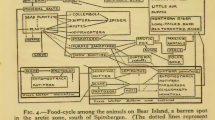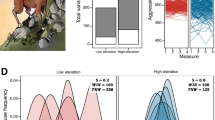Abstract
Meta-analysis now pervades ecology and evolutionary biology as the tool of choice for the synthesis of primary results. In the opening article of this special issue on “Meta-analytic insights into evolutionary ecology”, we begin by contrasting meta-analysis with the more traditional ‘narrative’ reviewing approach. Although it is not without faults, we find that meta-analysis usually outperforms qualitative reviews with respect to testing hypotheses, identifying sources of heterogeneity among primary results, assessing publication bias, and even generating new hypotheses and future research directions. We then highlight the key messages of the nine other contributions to this special issue, on the topics of natural selection, sexual selection, community ecology, host-parasite interactions, plant evolutionary ecology, social behaviour, behavioural syndromes, conservation biology, and methodological advances. We also discuss issues associated with the quality assessments and the inadequate reporting of basic statistics in primary empirical studies, and the need to share credit with the authors of those primary studies through actual citations. Finally, we turn to the future and argue that meta-analysis needs to adopt the principles of systematic reviews, following strict protocols that facilitate replicable and updatable research syntheses. Ecology and evolutionary biology urgently need collaborative networks such as the Cochrane Collaboration in the medical sciences, to oversee the standards of systematic reviews and meta-analyses. The formation of a collaborative meta-analytic research network will be an important step for meta-analysis to solidify its central role in research and data synthesis.

Similar content being viewed by others
References
Arnqvist G, Kirkpatrick M (2005) The evolution of infidelity in socially monogamous passerines: the strength of direct and indirect selection on extrapair copulation behavior in females. Am Nat 165:S26–S37
Arnqvist G, Wooster D (1995) Meta-analysis: synthesizing research findings in ecology and evolution. Trends Ecol Evol 10:236–240
Arnqvist G, Rowe L, Krupa JJ, Sih A (1996) Assortative mating by size: a meta-analysis of mating patterns in water striders. Evol Ecol 10:265–284
Booth A, Clarke M, Dooley G, Ghersi D, Moher D, Petticrew M, Stewart L (2012) The nuts and bolts of PROSPERO: an international prospective register of systematic reviews. Syst Rev 1:2
Bushman BJ, Wang MC (2009) Vote-counting procedure in meta-analysis. In: Cooper H, Hedges LV, Valentine JC (eds) The handbook of research synthesis and meta-analysis. Russell Sage Foundation, New York
Cadotte MW, Mehrkens LR, Menge DNL (2012) Gauging the impact of meta-analysis on ecology. Evol Ecol. doi:10.1007/s10682-012-9585-z
Caldwell DM, Welton NJ, Ades AE (2010) Mixed treatment comparison analysis provides internally coherent treatment effect estimates based on overviews of reviews and can reveal inconsistency. J Clin Epidemiol 63:875–882
Castellanos MC, Verdú M (2012) Meta-analysis of meta-analyses in plant evolutionary ecology. Evol Ecol. doi:10.1007/s10682-012-9562-6
Cohen J (1988) Statistical power analysis for the behavioral sciences, 2nd edn. Lawrence Erlbaum, Hillsdale
Cooper H, Hedges LV, Valentine JC (2009) The handbook of research synthesis and meta-analysis, 2nd edn. Russell Sage Foundation, New York
Cornwallis CK, West SA, Griffin AS (2009) Routes to indirect fitness in cooperatively breeding vertebrates: kin discrimination and limited dispersal. J Evol Biol 22:2445–2457
Côté IM, Reynolds JD (2012) Meta-analysis at the intersection of evolutionary ecology and conservation. Evol Ecol. doi:10.1007/s10682-012-9568-0
Egger M, Smith GD, Altman DG (2001) Systematic reviews in health care: meta-analysis in context. 2nd edn. BMJ, London
Endler JA (1986) Natural selection in the wild. Princeton University Press, Princeton
Fletcher D, Dixon PM (2012) Modelling data from different sites, times or studies: weighted versus unweighted regression. Methods Ecol Evol 3:168–176
Forstmeier W, Martin K, Bolund E, Schielzeth H, Kempenaers B (2011) Female extrapair mating behavior can evolve via indirect selection on males. Proc Nat Acad Sci USA 108:10608–10613
Garamszegi L, Nunn CL (2012) Informatics approaches to develop dynamic meta-analyses. Evol Ecol. doi:10.1007/s10682-012-9592-0
Garamszegi L, Markó G, Herczeg G (2012) A meta-analysis of correlated behaviours with implications for behavioural syndromes: mean effect size, publication bias, phylogenetic effects and the role of mediator variables. Evol Ecol. doi:10.1007/s10682-012-9589-8
Glass GV (1976) Primary, secondary, and meta-analysis of research. Educ Res 5:3–8
Griffin AS, West SA (2003) Kin discrimination and the benefit of helping in cooperatively breeding vertebrates. Science 302:634–636
Gurevitch J, Hedges LV (1999) Statistical issues in ecological meta-analyses. Ecology 80:1142–1149
Hadfield JD, Nakagawa S (2010) General quantitative genetic methods for comparative biology: phylogenies, taxonomies and multi-trait models for continuous and categorical characters. J Evol Biol 23:494–508
Halliday T, Arnold SJ (1987) Multiple mating by females—a perspective from quantitative genetics. Anim Behav 35:939–941
Hedges L, Olkin I (1985) Statistical methods for meta-analysis. Academic Press, New York
Higgins JP, Green S (2008) Cochrane handbook for systematic reviews of interventions. Wiley, Chichester
Higgins JPT, Thompson SG (2002) Quantifying heterogeneity in a meta-analysis. Stat Med 21:1539–1558
Higgins JPT, Thompson SG, Deeks JJ, Altman DG (2003) Measuring inconsistency in meta-analyses. Brit Med J 327:557–560
Ioannidis JPA (2009) Integration of evidence from multiple meta-analyses: a primer on umbrella reviews, treatment networks and multiple treatments meta-analyses. Can Med Assoc J 181:488–493
Ioannidis JP (2010) Meta-research: the art of getting it wrong. Res Synth Methods 3:169–184
Jackson D, Riley R, White IR (2011) Multivariate meta-analysis: potential and promise. Stat Med 30:2481–2498
Jarvinen A (1991) A meta-analytic study of the effects of female age on laying date and clutch size in the great tit Parus major and the pied flycatcher Ficedula hypoleuca. Ibis 133:62–66
Jennions M, Kahn AT, Kelly CD, Kokko H (2012) Meta-analysis and sexual selection: past studies and future possibilities. Evol Ecol. doi:10.1007/s10682-012-9567-1
Jennions MD, Lorite C, Rosenberg M, Rothstein H (2013) Publication and related biases. In: Koricheva J, Gurevitch J, Mengersen K (eds) The handbook of meta-analysis in ecology and evolution. Princeton University Press, Princeton
Kingsolver JG, Diamond SE, Siepielski AM, Carlson SM (2012) Synthetic analyses of phenotypic selection in natural populations: lessons, limitations and future directions. Evol Ecol. doi:10.1007/s10682-012-9563-5
Koricheva J, Gurevitch J, Mengersen K (2013) The handbook of meta-analysis in ecology and evolution. Princeton University Press, Princeton
Kueffer C, Niinemets U, Drenovsky RE, Kattge J, Milberg P, Poorter H, Reich PB, Werner C, Westoby M, Wright IJ (2011) Fame, glory and neglect in meta-analyses. Trends Ecol Evol 26:493–494
Lajeunesse MJ (2010) Achieving synthesis with meta-analysis by combining and comparing all available studies. Ecology 91:2561–2564
Liberati A, Altman DG, Tetzlaff J, Mulrow C, Gotzsche PC, Ioannidis JPA, Clarke M, Devereaux PJ, Kleijnen J, Moher D (2009) The PRISMA statement for reporting systematic reviews and meta-analyses of studies that evaluate health care interventions: explanation and elaboration. Plos Med 6(7):e1000100, BMJ 339:b2700
Littell JH, Corcoran J, Pillai V (2008) Systematic reviews and meta-analysis. Oxford University Press, Oxford
Majolo B, Aureli F, Schino G (2012) Meta-analysis and animal social behaviour. Evol Ecol. doi:10.1007/s10682-012-9559-1
Moher D, Liberati A, Tetzlaff J, Altman DG, Grp P (2009) Preferred reporting items for systematic reviews and meta-analyses: the PRISMA statement. Plos Med 6:e1000097
Møller AP, Jennions MD (2001) Testing and adjusting for publication bias. Trends Ecol Evol 16:580–586
Nakagawa S, Cuthill IC (2007) Effect size, confidence interval and statistical significance: a practical guide for biologists. Biol Rev 82:591–605
Nakagawa S, Santos ESA (2012) Methodological issues and advances in biological meta-analysis. Evol Ecol. doi:10.1007/s10682-012-9555-5
Ord TJ, Stamps JA (2009) Species identity cues in animal communication. Am Nat 174:585–593
Petticrew M, Roberts H (2006) Systematic reviews in the social sciences. Blackwell, Oxford
Poulin R, Forbes MR (2012) Meta-analysis and research on host–parasite interactions: past and future. Evol Ecol. doi:10.1007/s10682-011-9544-0
Reale D, Dingemanse NJ, Kazem AJN, Wright J (2010) Evolutionary and ecological approaches to the study of personality. Philos T R Soc B 365:3937–3946
Reichman OJ, Jones MB, Schildhauer MP (2011) Challenges and opportunities of open data in ecology. Science 331:703–705
Rosenthal R (1979) The “file drawer problem” and tolerance for null results. Psychol Bull 86:638–641
Rothstein HR, Sutton AJ, Borenstein M (2005) Publication bias in meta-analysis. Wiley, Chichester
Schino G (2001) Grooming, competition and social rank among female primates: a meta-analysis. Anim Behav 62:265–271
Schino G, Aureli F (2008) Grooming reciprocation among female primates: a meta-analysis. Biol Lett 4:9–11
Schino G, Aureli F (2010) The relative roles of kinship and reciprocity in explaining primate altruism. Ecol Lett 13:45–50
Stewart G (2010) Meta-analysis in applied ecology. Biol Lett 6:78–81
Sutton AJ, Higgins JPI (2008) Recent developments in meta-analysis. Stat Med 27:625–650
Thompson SG, Higgins JPT (2002) How should meta-regression analyses be undertaken and interpreted? Stat Med 21:1559–1573
Valentine JC (2009) Judging the quality of primary research. In: Hedges LV, Valentine JC, Cooper H (eds) The handbook of research synthesis and meta-analysis. Russell Sage Foundation, New York, pp 129–146
Whittaker RJ (2010) Meta-analyses and mega-mistakes: calling time on meta-analysis of the species richness-productivity relationship. Ecology 91:2522–2533
Wilkinson L (1999) Statistical methods in psychology journals—guidelines and explanations. Am Psychol 54:594–604
Acknowledgments
The authors thank John Endler for conceiving this special issue and Losia Lagisz for figure preparation, and Alistair Senior, Amanda Valois and two anonymous referees for comments on earlier versions of this manuscript. SN is supported by NRCGD.
Author information
Authors and Affiliations
Corresponding author
Rights and permissions
About this article
Cite this article
Nakagawa, S., Poulin, R. Meta-analytic insights into evolutionary ecology: an introduction and synthesis. Evol Ecol 26, 1085–1099 (2012). https://doi.org/10.1007/s10682-012-9593-z
Received:
Accepted:
Published:
Issue Date:
DOI: https://doi.org/10.1007/s10682-012-9593-z




